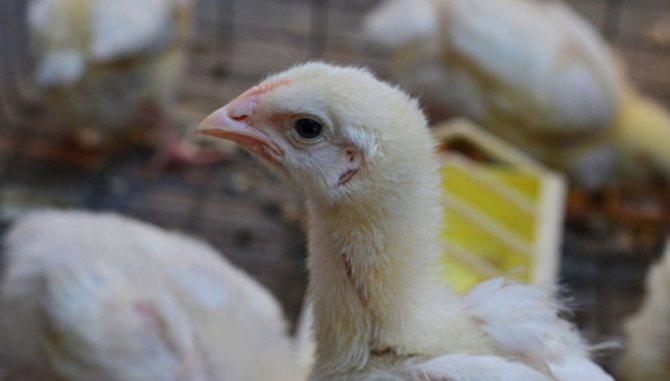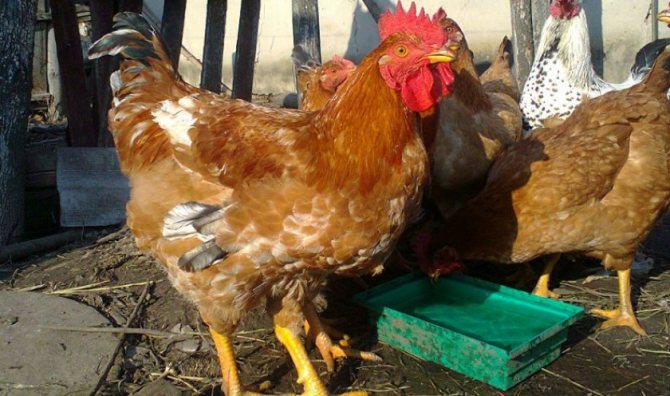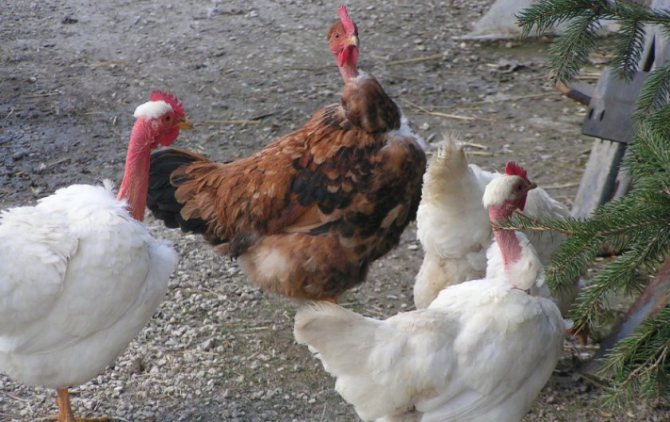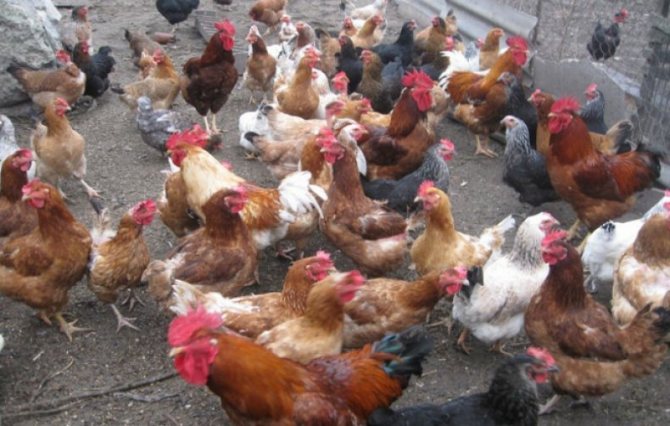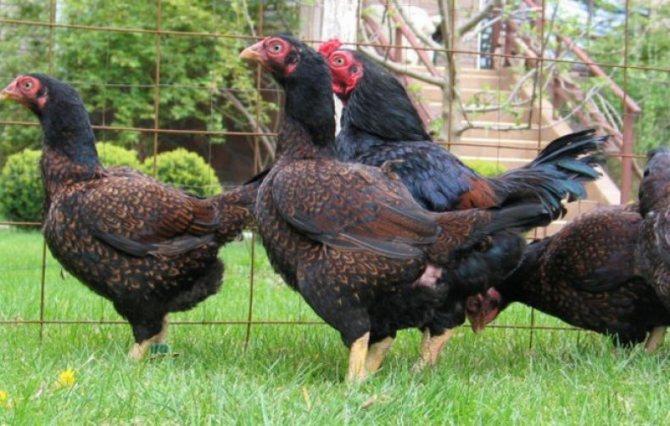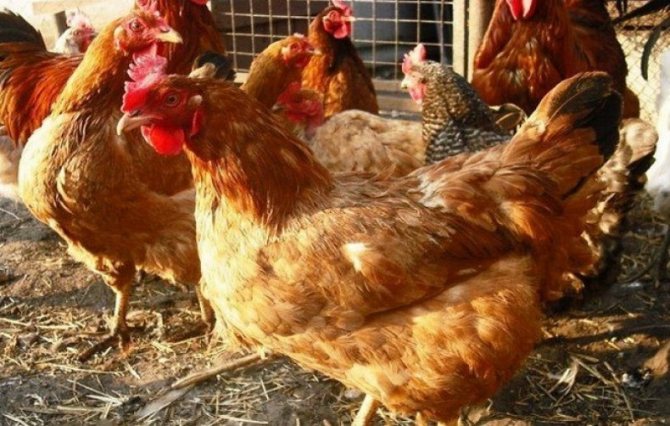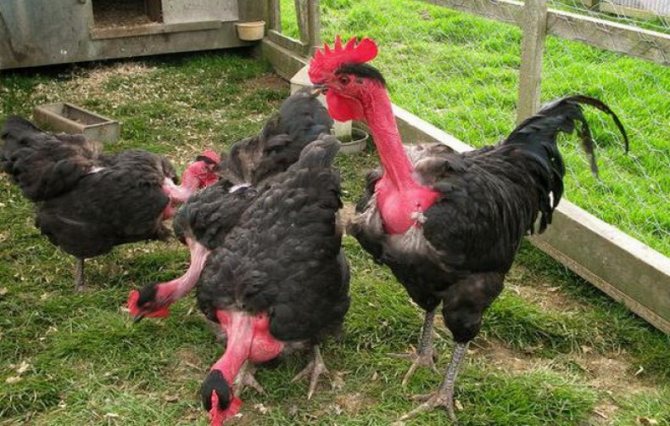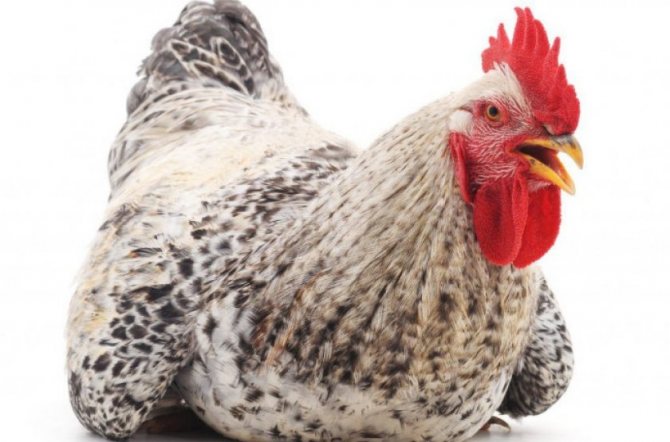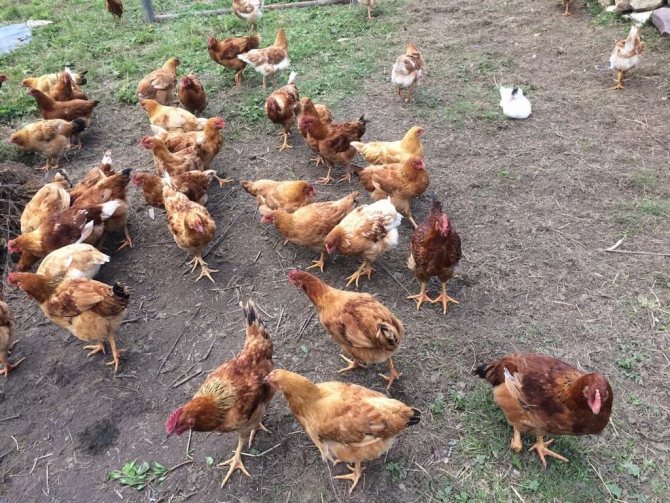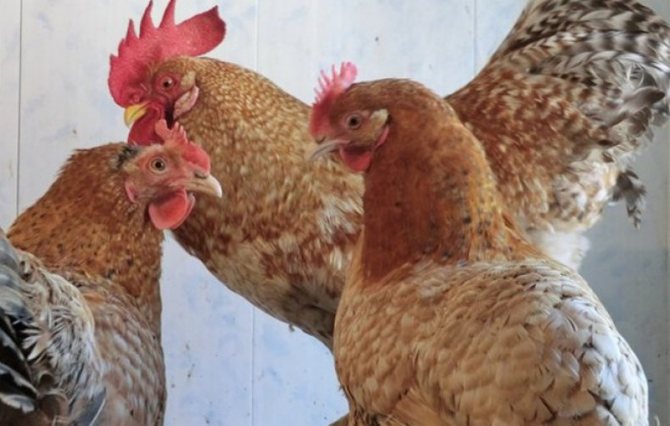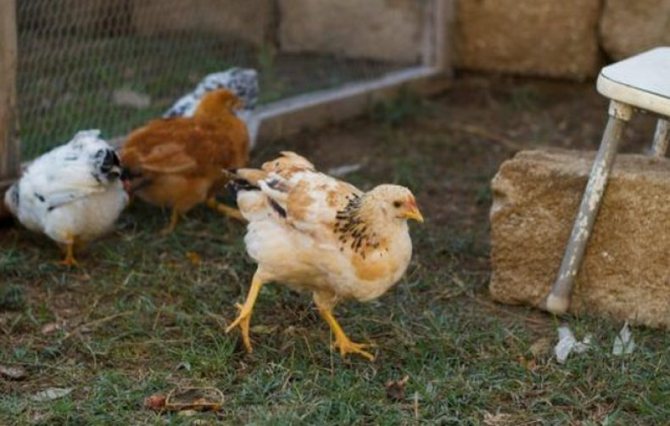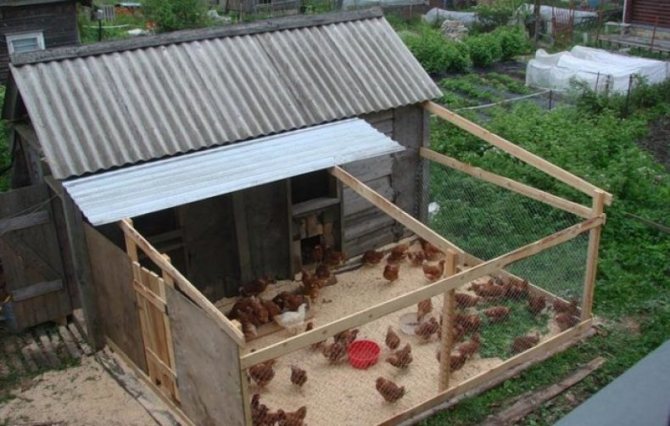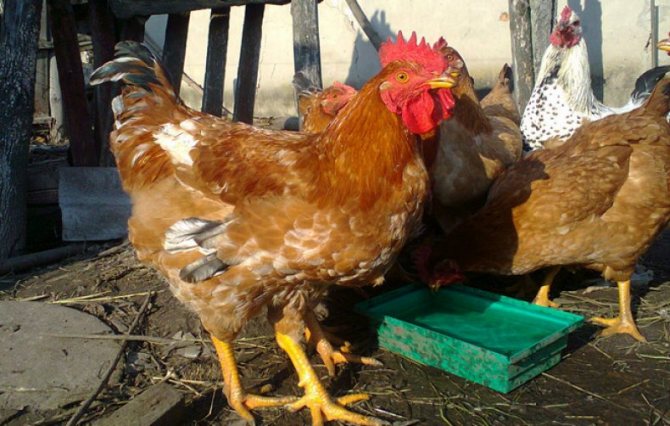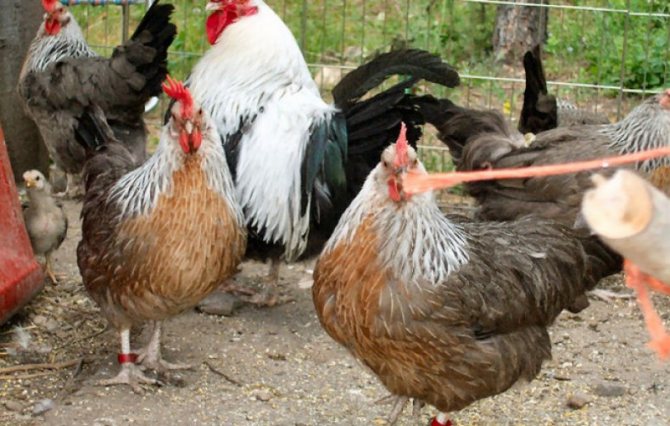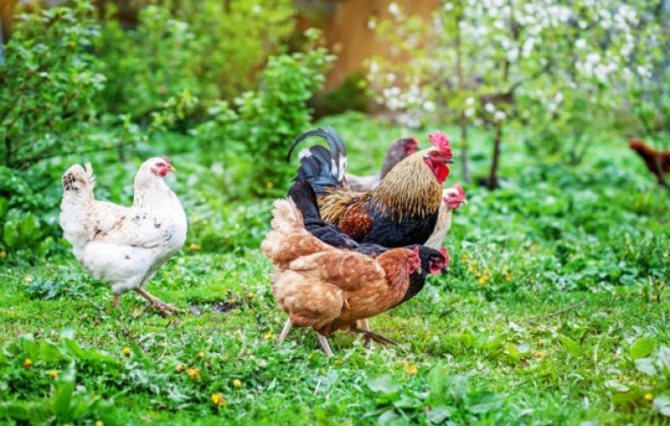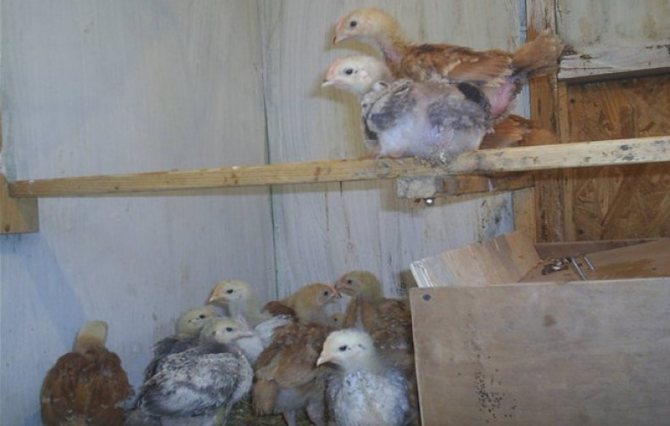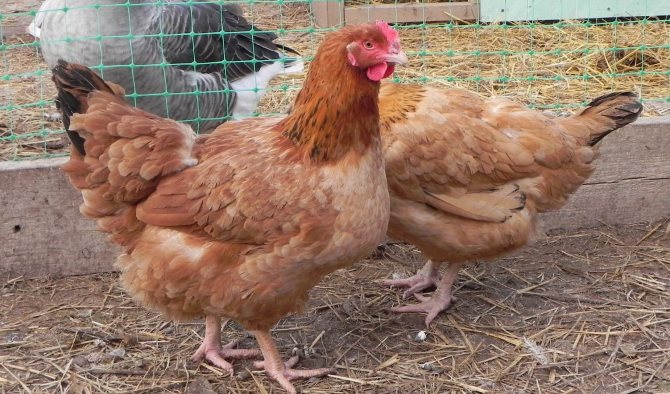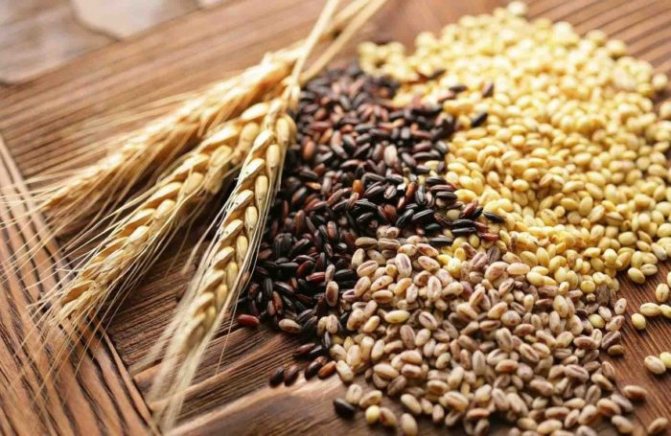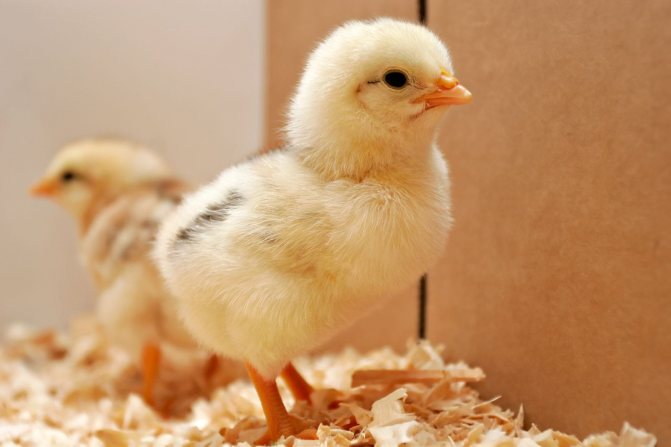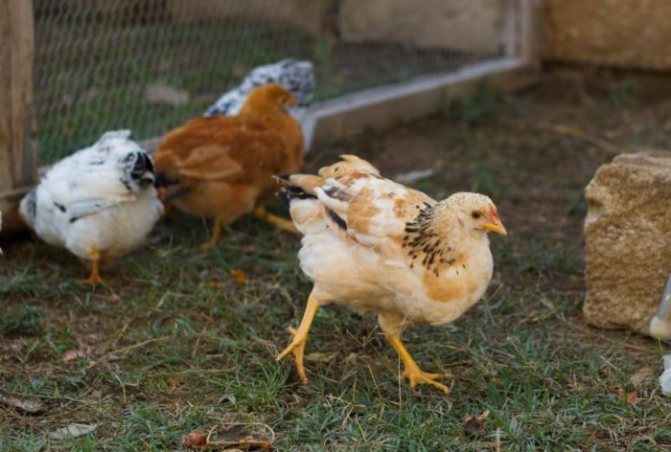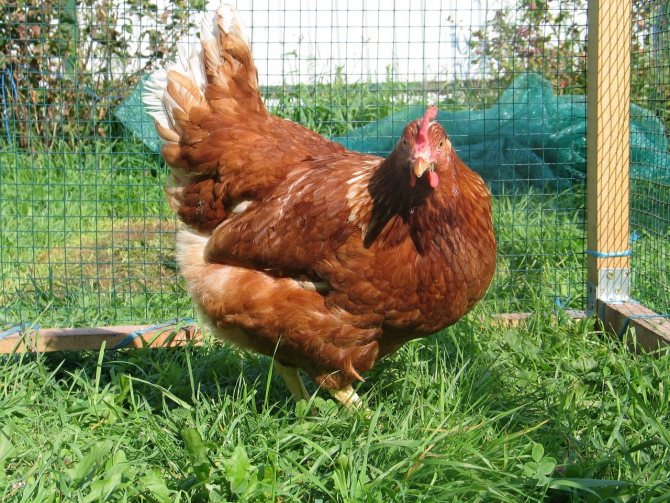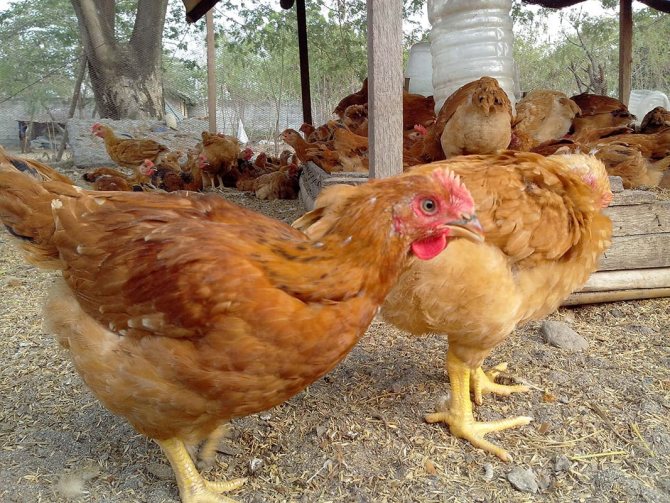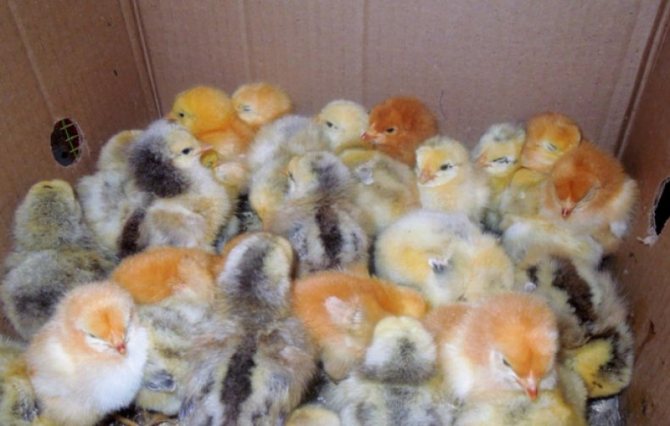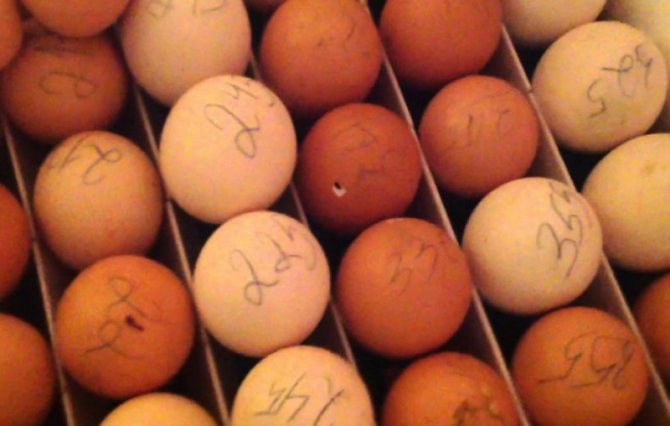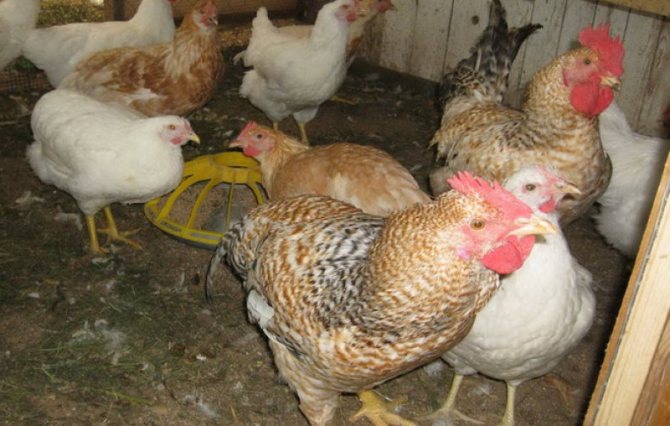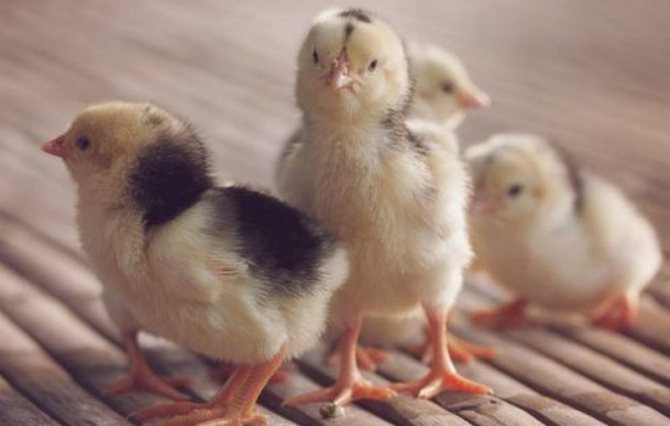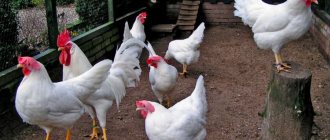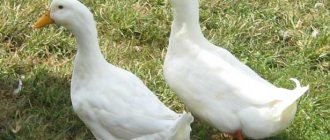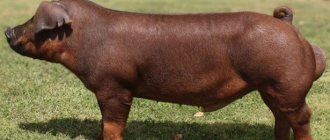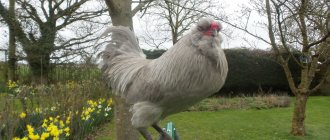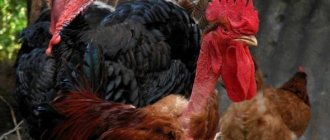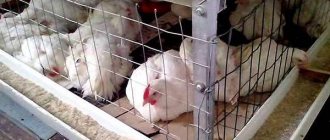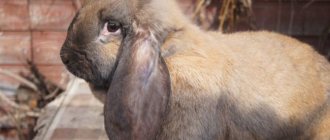Poultry »Chickens
0
3000
Article rating
Colored broilers are currently very popular in European countries. Their homeland is France, but over time they spread throughout the mainland. On the territory of Russia, some farmers have already started such a breed. In particular, the colored broiler sasso xl 551 is known.
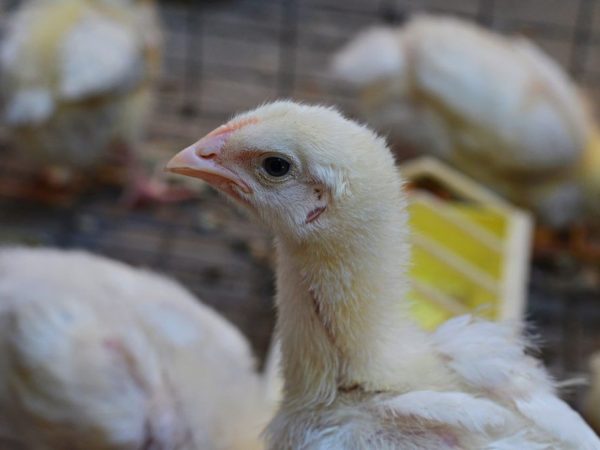
Colored broilers Sasso
At the present stage of agricultural development, broiler breeding is considered not only profitable, but also extremely exciting. The spread of this industry is due to the fact that chickens stand out favorably in their weight category among other breeds and are actively growing. Among other things, they are completely unpretentious to care for.
There is more than one type of broiler, but colored broilers are considered the most popular among breeders, more precisely, the Sasso species. Before buying birds of the color broiler breed, you should study the description in detail, pay attention to what the characteristics of the breed are, see photos and videos, and also read the reviews.
External description of a colored broiler
These are birds of strong constitution, with an elongated body, wide back and chest. They have a small head, short stature, strong bones and well-developed muscles. The birds are decorative: bright, diverse plumage, light skin.
With proper care and feeding, the birds will have the next productivity.
- The maximum weight for males is 7 kg, for hens 4 kg.
- Chickens add up to 50-60 grams per day. At the age of one month, broilers weigh 800-1000 grams. Broilers are slaughtered at two months of age. By this time, the weight of the birds is from two to two and a half kilograms.
- Colored broilers have high egg production. Laying hens bring up to 300 eggs per year.
- The survival rate of young animals is up to 98% with proper care.
- High quality of the resulting product, as it contains a lot of valuable white meat.
Distinctive external features of the described broilers are:
- elongated torso,
- massive chest,
- straight back,
- strong bones
- light skin tone,
- well-developed muscles,
- small growth.
How were they bred?
Broilers are a hybrid variety bred by crossing several breed lines. To obtain hybrids, meat and meat-egg directions are used. Broilers are not a breed at all, but the popular name for meat chickens. The birds are specially bred for the meat. The word "broiler" is translated as "fry", which means that chicken meat is suitable for frying over a fire.
Initially, for the sake of obtaining hybrids, they took breeds of birds such as the Cornish and White Plymouth Rock. The Cornish were attracted as fathers and the Plymouth Rocks as brood hens. Breeds such as New Hampshire, Brahma, Fighting Cornish, Langshan, Jersey Black Giant are used to breed new broiler chickens.
Broilers obtained from crossing are distinguished by developed meat forms, high weight, large breast and excellent taste characteristics of meat. Broiler chickens grow rapidly and gain weight. They eat as much as common chickens. Growing a broiler for up to 2 months (before slaughter) takes 2-3 kilograms of dry feed. At two months of age, they weigh 2 or more kilograms, the weight of an adult chicken is almost 5 kilograms.
In the production of chickens, special requirements are imposed on the commercial quality of carcasses. The bird should not have dark feathers and dark skin. Parent breeds should have a dominant, snow-white plumage and yellowish (pale) skin.
As a result of crossing, chickens with light (sometimes red) feathers are obtained. The hybrids have a large body, a small head, and muscular legs. Birds have poorly developed ridges and beards. Chickens are inactive, they have a calm nature.
Broilers are active in gaining live weight. At 6-9 weeks of age, the chickens are ready for slaughter. At this age, their weight is 2.45-3 kilograms. Broilers lay well, they produce about 120-180 eggs per year. However, all the positive qualities of the parents are not passed on to their offspring. Broiler chickens are bred only by selective breeding.
In order to breed broilers, you need to buy ready-made day old chicks or hybrid hatching eggs.
Conditions for successfully growing broilers at home
To preserve the chicks and raise healthy and strong broilers from them, the young need to be properly looked after and rationally fed.
Broiler care
- Keeping chickens requires a warm, dry and light-colored house. The temperature in it should not fall below 2C and rise above 27C. In the early days, chickens need a temperature of at least 25C, then it can be gradually reduced.
- Birds are raised both in cages and on the floor. In the second case, no more than ten chickens can be placed on one square meter of the floor.
- Use hay or sawdust as bedding. Change the litter more often to keep it dry. Keeping the house clean and dry will minimize the chance of infection.
- The illumination of the house is required average. Only the feeders should remain brightly lit.
If the disease could not be avoided, try to find out the cause of the disease and eliminate it. A cough can start if the temperature and humidity are too low in the coop. It is necessary to insulate the room, make ventilation, eliminate drafts and install a heater.
Often, the cause of the disease is improper nutrition: poor feed, deficiency of protein, vitamins or trace elements. The diet of birds should be balanced, complete and appropriate for the age of the chicks.
Insects parasitizing birds are the main spread of infections. It is necessary to regularly carry out insecticidal treatment of the poultry house.
How to feed chickens
For feeding broilers, ready-made feed mixtures are used. They have a balanced composition, there are necessary trace elements and vitamins. If ready-made feeds are not available, you can make the mixture yourself. It includes:
- shit from corn, oats, wheat, barley;
- sunflower cake;
- yeast;
- meat and bone meal;
- low-fat cottage cheese.
The components are bred with yogurt.
Birds are fed with wet mash of grated carrots, cabbage and other vegetables, dandelion leaves, nettles, green onions.
Limestone, crushed shells, egg shells and chalk are added to food. They contain calcium for growth. Birds constantly need clean water.
Is it profitable to grow?
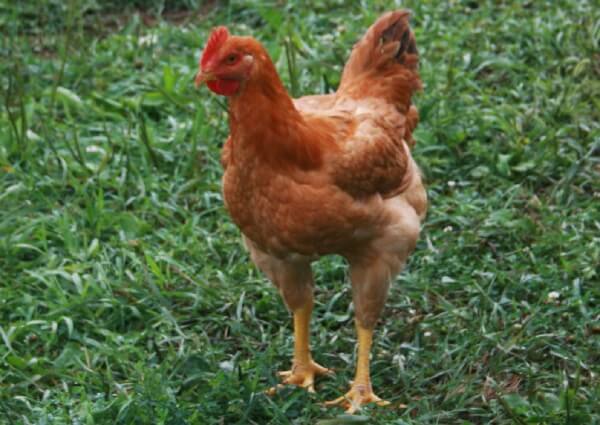

If you look at the economic perspective of keeping colored broilers, you can see that it is profitable. Evidence of this, in addition to the factors listed earlier (rapid weight gain, excellent egg production, high productivity), is:
- simultaneous, friendly growth and development of young animals;
- the safety of almost the entire brood, which avoids monetary losses;
- intense (in comparison with ordinary hens) puberty;
- low cost of the meat obtained;
- a high percentage of dietary white meat in the total mass of the slaughtered carcass.
And, of course, it is worth mentioning the richness of the plumage with a varied number of color shades.
About us
ECOFARM "LPH ZELENOV"
LPH Zelenov was organized in 2010. ... Head of the farm Sergey Gennadievich Zelenov, veterinarian and poultry specialist. LPH started its activity with 40 heads of chickens and very quickly we realized that keeping and raising chickens is a very profitable line of business. The very next year, the poultry population numbered 500 heads of chickens, every day they brought us up to 400 large, tasty eggs. Now our livestock is more than two thousand heads of poultry. Read the continuation in the article "About us"
Video review
Features of keeping such birds
Broilers require the same care as other breeds. They are suitable for cages and open chicken coops. Birds need to be provided with optimal conditions for keeping:
- nests for laying eggs;
- specialized food for broilers, enriched with protein and calcium;
- insulated room, protected from draft;
- it is recommended to install protection against rodents;
- cleaning is carried out every 2 days;
- disinfection is done once a year or more often;
- monitor the temperature regime, in summer it should be 20-25 ° С, in winter not lower than 5 ° С;
- in the place where chickens are kept, there must be free access to drinking bowls and feeders.
In addition to general care measures, it is advisable to inspect birds for ticks and diseases. Also check the chicken coop for ticks. In spring and summer, it is recommended to carry out pest control.
In keeping, this bird is unpretentious, but farmers should still adhere to some rules, namely:
- maintain the optimal temperature regime (15-25 ° C), not allowing the indicator to drop to 5 ° C. For young animals, the temperature at the place of their stay should be 25 ° C;
- exclude drafts at the location of the bird, close up the existing cracks;
- birds can be kept both in cages and on the floor, on a bed of straw and sawdust.
We invite you to read: Indian spotted knife
Once a year, it is required to disinfect the chicken coop, current cleaning - once every 2 days. The room containing colored broilers must be clean and dry. This is one of the prerequisites for high-quality bird growth and disease prevention.
There should be no more than 10 chicks on one square meter, a large accumulation can be fatal for the young.
Sasso breed of colored broiler chickens
Origin story.
As you already understood, the chicken in question was born in the vastness of France, where the taste of meat is highly valued. The local breeders wanted to develop a hen that would be a worthy alternative to broilers. Thanks to long-term work, about 35 years ago, another quota appeared in the world.
Sasso chicken XL551 and T751, unfortunately, did not become widespread outside the country, but, nevertheless, it became one of the most popular in its homeland. Today, of course, farmers all over the world grow it, but according to statistics, its livestock outside of France is not numerous. It is also known that chickens are popular in Asian countries.
Sasso chicken breed belongs to the meat type of productivity. This is a unique species that is famous not only for delicious meat, but also for unrealistic growth rates, and without hormones and all kinds of additives.
Character
Work on the variety is being carried out to this day. The company that deals with it continues to improve the birds. We can say for sure that their character is quite calm - the winged herd is not prone to aggression, is distinguished by its peacefulness, but at the same time it often suffers from stress.
Due to excessive shyness, the quality of the masonry may deteriorate. But, they are grown mainly for the sake of carcasses, so there are no problems due to fearfulness.
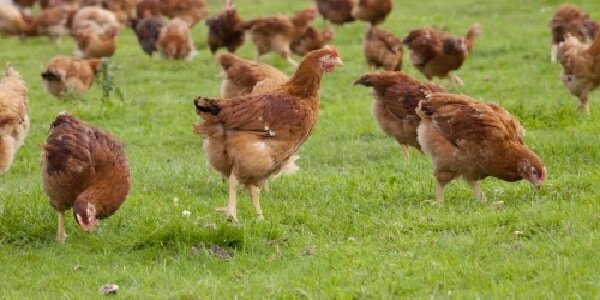

How to feed an adult herd?
Broiler feed is available on the market.They, as a rule, optimally combine all the trace elements necessary for rapid growth and medicinal components necessary for the prevention of possible diseases.
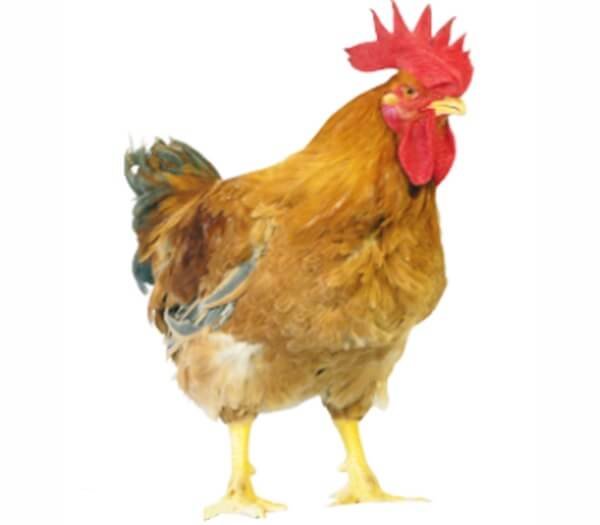

Feed, depending on the period of poultry rearing, are divided into:
- starting,
- growth,
- finishing.
You can prepare a composition for feeding colored broilers yourself. You will need the following ingredients:
- wheat turf (crushed grain) - 0.2 kg;
- corn poultry - 0.4 kg;
- barley grains - 0.05 kg;
- oatmeal - 0.1 kg;
- sunflower cake - 0.150 kg;
- fish flour - 0.06 kg;
- baker's yeast - 0.002 kg;
- low-fat cottage cheese - 0.2 kg.
The components should be mixed together, add yogurt to them. The calculation of the mixture for one chicken is 10-25 grams.
It is recommended to add any greens to the diet of an adult bird (cabbage leaves, young nettles, etc.). The vitamin complex can be replenished with chopped carrots; to increase calcium, chopped eggshells of raw or boiled eggs are recommended.
Along with the feed, fine gravel or shells should be added to the feeders - components necessary for proper digestion.
In principle, almost everyone can eat hens. Consider several features of the diet for adult representatives of the French cross.
- The adult family also needs a cereal-dominated diet.
- Cross producers recommend feeding with cereals, or, as they say, wet mash. Birds eat them with pleasure, and easily assimilate them.
- The grain basis of the diet is compound feed for broilers, which includes all the necessary complex of nutrients.
- In small quantities, you can add protein products of animal origin to the diet - fermented milk, meat, fish.
Keeping Sasso in a chicken coop or cage
When keeping birds in a chicken coop, cage or greenhouse, you need to take care of good conditions. In winter, the poultry house must be additionally heated with heating devices. There should be enough fresh air in the coop, which requires a good ventilation system. When heating systems are on, fresh air must be mandatory. To prevent chickens from blowing from ventilation or drafts, perches should be placed at a height of at least 60 cm from the floor. When growing birds in cages, the floor must be insulated, and the cages should be placed at a short distance from it. It is not recommended to over-ventilate the premises, as a draft can adversely affect the health of broilers. In cases where chickens live on the floor, care must be taken to keep their litter dry and clean at all times.
If the individual spills water on the litter or scatters wet mash, then it should be replaced with a new one, since various microorganisms are introduced into the wet material and the content becomes more complicated. Of course, it is very important to keep track of your diet. It must be carefully balanced. It is necessary to make a special table where a correctly composed diet will be written, taking into account all the characteristics and age of the bird. For young stock and layers, it is necessary to add more mineral and vitamin components to the diet. Also, do not forget about the daily walking of the livestock.
Many farmers who have recently started breeding this breed are surprised that when they walk, chickens peck the ground, they are interested in whether this process will harm the health of the livestock. No, this is completely normal, in this case broilers eat bugs, worms and grass that come across them. Laying hens run better on pasture, their meat tastes better, and this fact has long been proven. Many farmers release birds even in the cool season, at least for a walk of 5-15 minutes. This will only benefit them and will not do any harm, provided that the air temperature is not less than 5 ° C.You can learn more about the peculiarities of maintenance, breeding and care in a photo or video.
External characteristics
Scientists have worked hard to create several rulers with different external characteristics. But, the birds basically differ only in colors. There are many varieties. Due to this feature, chickens are often also referred to as "colored broilers". Here are some of the most common varieties.
- White.
- Palevye.
- Black.
- Blue.
- Red.
Some birds have bare necks, but most are fully feathered. The plumage is rigid, dense enough and voluminous. Birds are distinguished by a powerful physique. They have a wide body, squat, low rise.
Pronounced belly and chest, as well as a flat back. The body has a horizontal setting, on low, widely spaced paws.
The head is small, not unique - with a regular, leaf-shaped crest, which is slightly larger than that of many other species. The face, earrings and beak are red. The eyes are red-orange, or amber.
We suggest you familiarize yourself with: Dogo Canary breed description and features of the content
The maximum weight that can be expected from males is about 5 kg, and chickens tend to weigh 800-900 grams less. But, it should be borne in mind that weight indicators also differ for different lines of this breed.
The maximum weight that can be expected from males is about 5 kg, and chickens tend to weigh 800-900 grams less. But, it should be borne in mind that weight indicators also differ for different lines of this breed.
Naked Neck
The origin of this breed is not known for certain. The most common in Romania, Hungary, Germany. The most striking feature is the lack of feathering in the neck area, even in chickens. Feather color of all possible shades.
The colored broiler naked is medium-sized, has a dense fleshy body. The head is rounded in shape with plumage in the occipital part. The beak is slightly curved. The comb is upright, small in size, single or adjustable.
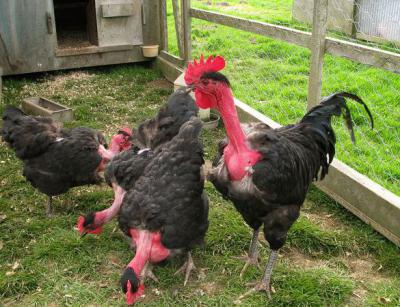

The neck is red, without plumage, curved. The base of the neck is decorated with fluffy feathers.
Convex wide rounded chest. The back is broad and flat. Wings tightly attached to the body. Strong, long tibiae, non-feathered metatarsus.
The bird adapts well to various climatic conditions, tolerates cold well, but because of its bare neck, it is still mainly bred in the southern regions.
Read also: How to keep quails at home in winter
The only drawback of colored broilers is the difficulty of their reproduction. Breeding young animals are best purchased at poultry farms or specialized enterprises.
The variety of colored broilers is explained by the natural desire of specialists to breed better breeds and crosses. Species diversity is ensured through the use of not only broilers as source breeds, but also poultry of meat-egg and egg directions.
Redbro breed
Colored broilers are available in several breeds. The article lists the most popular ones. First of all, this is RedBro - a derivative of the Cornish and Malaysian chickens. The homeland of RedBro is Foggy Albion. Representatives of this breed of colored broilers have developed muscles, strong legs. The plumage color is mostly red or red-brown, although white birds are rarely found.
Colored broilers of the RedBro breed are unpretentious in keeping, easily adapt to the climate and the specifics of domestic feed mixtures. They are characterized by good health, so they can be grown without the use of antibiotics, as is typical of other breeds of broilers.
The meat is fibrous, the taste is at a high level.Chickens begin to lay eggs at 6 months of age, the average annual rate is 300 eggs. At six months, the weight of the laying hen is 3 kg, the cockerel is 4.5 kg.
Advantages and disadvantages of a hybrid
Despite the fact that the chicken is inferior to many broilers and egg hybrids, it still has a lot of "fans" who prefer to keep a representative of this particular cross in their yard. This is due to a number of advantages that Redbro offers to farmers:
- This is a strong enough bird. Her survival rates are high at all stages of a chicken's life.
- The bird gains weight very quickly, which makes it competitive against promising broilers.
- The meat is very tasty, juicy, especially if it is young.
- In addition to meat products, chickens give a fairly large number of eggs as for meat and egg cross.
- The bird has a gentle, non-conflict and friendly character.
- Redbro is a very hardy cross. It adapts to different conditions of detention.
- Chickens and cockerels (especially) have an attractive decorative appearance.
Are there any disadvantages. Unfortunately, like any other cross, there are:
- Firstly, Redbro cannot be removed at home. The chicken should only be purchased from official breeders.
- Secondly, the appearance of the Redbro is similar to other, less productive breeds, which is often used by unscrupulous sellers.
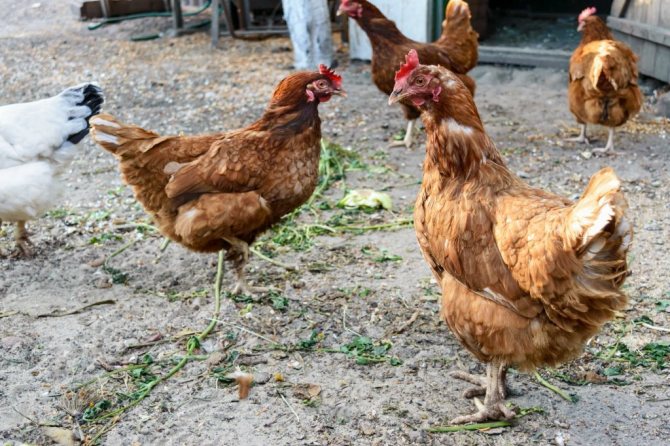

Chickens Master Gris
Master Gris is a French colored broiler, unpretentious and hardy. The plumage of the bird is predominantly white or with a mixture of gray. The average weight of males at 2 months of age is 7 kg, laying hens - 4 kg. The high survival rate of young animals is 98.
French colored broilers grow well in cages, open-air cages, and in conditions of partial freedom. Females begin to lay at about 4 months, producing 280-300 large eggs per year.
The meat is tasty, the fat content is low, which plays into the hands of supporters of various diets. Good muscle gains can be achieved by feeding a high protein formula.
Puberty and egg production
Winged beauties are not very active in egg-laying, but mature quickly. At about 4-5 months, you can get the first testicles from winged French women. Rarely are developmental delays, which are most often associated with genetic problems or with a violation of the rules of nutrition and care.
The maximum number of eggs that can be obtained from a laying hen in a year is 120 pieces. Such a figure cannot impress modern farmers. Moreover, the average weight of the testicles is 55-60 grams. The shell is white or beige.
Pros and cons of tricolor breeding
All of the above information, and the description of the breed itself, speaks about how profitable the cultivation of this breed is. To summarize all the information, you can highlight the main factors that will emphasize the high efficiency of chicken breeding:
- to keep this breed, you do not need to adhere to any specific rules, they are unpretentious either in food or in conditions;
- growing them does not require spending large sums;
- young individuals quickly grow and gain weight, so the cost of chicks pays off well in a relatively short time;
- unlike their relatives, the breed does not lend itself to the influence of many viruses, their immune system allows you to overcome various diseases.
By adhering to the rules of feeding and caring for birds, you can get quality products and a good income. The predominant range of breed content and the absence of disadvantages guarantee the popularity and profitability of this type of domestic hens.
Hungarian Giant
A prominent representative of colored broilers is the Hungarian Giant. In Russia, this breed is quite popular, if only because it has a rich feather cover, with which it can easily tolerate temperature changes. This is mentioned in many reviews of amateur poultry breeders.
Layers are distinguished by a developed maternal instinct, they incubate in the nest for the entire relying period, which is a determining factor for breeders who decide to breed offspring in a natural way. In the future, the females also responsibly continue to nurture the offspring that was born.
Incubation instinct
Chickens of the Sasso breed, whose description says about the difficulties in breeding, rarely become caring mothers for their offspring. Representatives of some lines can hatch eggs, but they are far from always able to complete the process.
The Sasso breed of chickens is bred only with the help of an incubator. The breed turned out to be genetically resistant, and in the next generation the chicks will inherit the parental characteristics.
The Sasso breed of chickens is bred only with the help of an incubator. The breed turned out to be genetically resistant, and in the next generation the chicks will inherit the parental characteristics.
Eco-farm is engaged in the following activities:
Raising and selling hens pullets of the High Line Brown breed, red bird, brown egg.
Raising and selling hens pullets of the Dekalb White breed, white bird, white egg.
Implementation of incubation eggs of European and Russian producers.
Incubation of poultry eggs.
Realization of day-old and reared chicken.
Production of compound feed on an environmentally friendly basis.
Sale of protein concentrates, grain feed, and mixtures thereof.
Production and sale of poultry cages.
Manufacture and sale of automatic poultry drinkers.
Manufacturing and sale of incubators.
Sale of bioorganic fertilizers (poultry manure humus).
Photos of the farm can be found here.
Diseases and drugs
The causes of poultry diseases are different. This can be high humidity in the room where the chickens are kept, or low temperature. Installing a heater and additional ventilation will help solve this problem. But if the feathered individual began to cough, urgent measures should be taken and the bird should be saved with medications. These are Baycox, Tetramisole 10, Enroxil, Metronidazole. In this case, it is important to observe the dosage prescribed in the instructions.
We suggest that you familiarize yourself with: Diseases of domestic chickens, symptoms and treatment
"Tetramisole" is also recommended as a prophylactic agent. Its action is aimed at destroying helminths.
Baycox is used to treat coccidiosis. The drug is capable of destroying species and strains that have increased resistance to other anti-coccidial drugs.
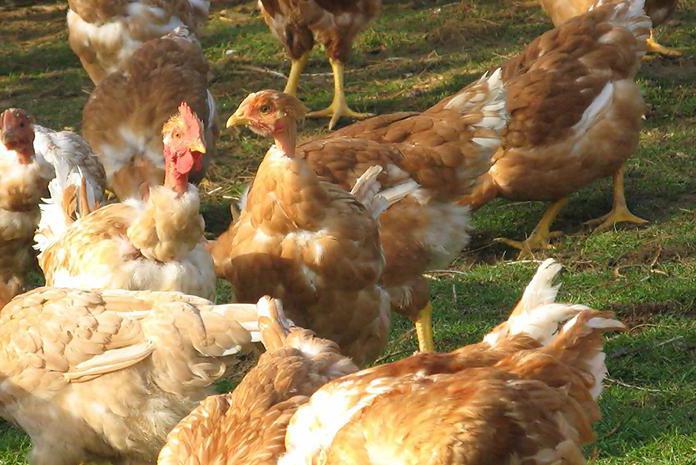

Enroxil. The action of this tool is aimed at treating diseases caused by bacterial infections and viral microorganisms.
"Metronidazole" is an antiparasitic drug characterized by a pronounced antibacterial effect against many common diseases, including:
- trichomoniasis,
- coccidiosis,
- histomoniasis.
Also, this antibiotic can be used for prophylactic purposes.
Chickens
The main feature of the species in question is that the chicks gain weight very quickly. The minimum age at which young animals can already be sent for slaughter is 65-80 days. At this point, they can weigh about 2.5 kg.
Due to this quality, the colored leaves have attracted poultry owners looking to raise chickens for profit. The fact is that the consumption of feed in this case is minimal, and the invested money pays off very quickly.
Consider the features of weight gain at different age periods.
- Age 3 weeks - about 305 grams.
- 6 weeks - 900 grams.
- 2 months - 1.5 kg.
- 80 days - 2.5-3 kg.
It is worth noting that some lines do not differ in rapid growth, therefore, the above data are considered averaged.Depending on the variety, chicks differ in growth and maturation rates.
When it comes to feeding colored babies, there are some subtleties. French farmers claim that babies eat almost everything, and can eat traditionally - mixed feed for broilers, with a high protein content, as well as herbs and vegetables.
But, the difference is that the younger generation needs to make up the diet in such a way that 75% of it consists of dry grain.
Immunity
This is a strong enough hen, but she can face the following diseases:
- Dyspepsia is a disturbance in the normal functioning of the stomach. This disease most often occurs in young individuals, which are very early transferred to roughage, which is very difficult for chickens to digest. In adults, dyspepsia most often appears due to the fact that they drink dirty water. Symptoms of the disease: diarrhea with pieces of undigested food, fever, full belly. Treat this disease by changing the diet of the chicken. In the case of dirty water, it is temporarily replaced with a weak manganese solution.
- Goiter atony - this disease occurs due to the accumulation of food in the goiter. The congestion creates an obstruction. If this problem is noticed, it must be resolved immediately. Failure to do so may result in airway entrapment, resulting in death of the bird. The symptom of goiter atony is a hard and sagging goiter. A bird with this disease is treated as follows: a little oil is instilled into its goiter and a light massage is performed, which is aimed at extracting the contents of the goiter.
- Avitaminosis is a common disease that broilers and chickens who are kept in cages are very often faced with. With vitamin deficiency, inhibited weight gain, lethargy of the bird, its baldness, etc. are observed.
- Bronchopneumonia - occurs due to severe hypothermia. Symptoms of this disease: rapid breathing, loss of appetite, the formation of mucus in the beak. For the treatment of bronchopneumonia, penicillin or terramycin is used.
In addition to diseases, chickens may encounter parasitic diseases, such as:
- Infestation by helminths. Helminths are very diverse, respectively, the symptoms can also differ depending on what parasites the bird is infected with. Common symptoms of helminth infestation are diarrhea and anxiety in the bird.
- Trematodes. These pests significantly reduce the performance of Redbro. Also, because of this parasite, the hen can lay eggs, which will have no shell. Symptoms of the disease: inflamed cloaca, anxiety, apathy. Get rid of this parasite with carbon tetrachloride.
- Down and feathers. These are very common pests that can infest any poultry without exception. As it is not difficult to guess from the name, the parasites eat away feathers and down from chickens, leaving bald spots all over the body. Pests can deprive the hen of most of its plumage. They destroy pests with the help of special insecticidal preparations.
Possible growing problems
When growing broilers, they face problems:
- chickens can peck each other due to lack of nutrients;
- if sufficient nutrition is not provided, broilers will not be able to gain weight;
- low weight gain is observed with a large walking area, birds spend a lot of energy;
- due to high humidity, infectious diseases occur;
- egg production decreases due to tick damage and stress.
Occasionally, the poultry farmer will watch a colored broiler limp. The problem with legs is quite common in this type of bird and can be caused by several factors:
- poor feed quality,
- imbalance in mineral content,
- lack of calcium,
- mold indoors.
Lack of calcium can be replenished by adding shells, chalk, limestone or bone meal to the feed.
Also one of the problems faced by poultry farmers and mentioned in their reviews is the slow growth of colored broilers. This problem can be caused by the following circumstances:
- too much walking area. For broilers, this is unacceptable, since the bird must be sedentary most of the time, for a full set of live weight;
- inconsistency with the recommended values of the temperature regime;
- lack of protein in the diet, which negatively affects the set of muscle mass.
The saddest factor in growing colored broilers, according to breeders, is the death of chicks, which may be facilitated by the following circumstances:
- poor house ventilation and poor lighting;
- high humidity and dirt in the room;
- diseases - coccidiosis, intestinal infections;
- poor quality nutritious diet;
- non-receipt of special vitamins after the withdrawal of young animals.
It is worth noting that among color broilers there is such a phenomenon as pecking each other. It occurs due to a lack of vitamins and minerals in the feed, as well as excessive lighting in the house.
Vaccination of young animals
The daily young growth of colored broiler chickens is subject to vaccination. The procedures are best done after consulting a veterinarian. Some vaccinations are given to birds on a one-time basis, others - annually.
Sick, weak or emaciated individuals are not vaccinated. Vaccination methods are used, such as instillation in the eyes and nose, spraying, drinking, adding medicine to the feed, intramuscular injection.
Separate medicines should be in the medicine cabinet of any poultry farmer. For the prevention of helminths, Tetramisole is used twice a year. In the treatment of infectious diseases, viruses, digestive disorders, Enroxil is used. Baycox is used to prevent and treat coccidiosis.

